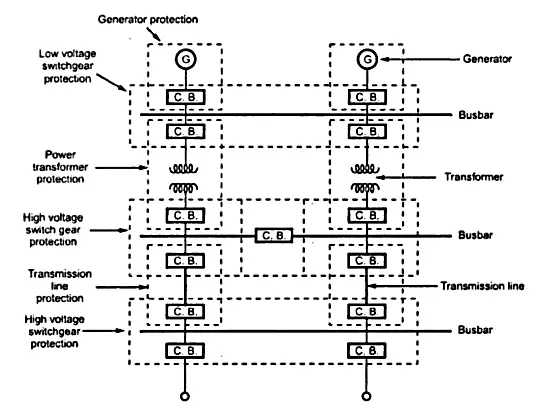A power system deals with generation, transmission, and distribution of electrical power. Transformers, generators, bus bars, transmission & distribution lines, circuit breakers, etc. are the elements or equipment of a power system. Each element or equipment of the power system has its own protective scheme. For example, transformer protection, generator protection, bus bar protection, transmission line protection, etc. In this way, a power system is divided into several protection zones. We study the topic “zones of protection in power system” under the power system protection.
What is a Protective Zone in Power System?
In this context, a protective zone refers to a zone established around each system element. Any fault occurring within a protective zone will cause the relays to trip, which will open all the circuit breakers within that zone.
One or at most two elements of a power system are covered by a protective zone. The protective zones are planned in such a way that they cover the entire power system collectively, no portion of the power system will be left out of protection. Figure 1 illustrates the various protective zones of a typical power system.

Note: There must be overlap between adjacent protective zones in a power system. It ensures that no part of the system is left unprotected.
Why Protective Zones are Overlapped?
It is necessary to overlap adjacent protective zones so that each and every element of the system is completely safe. In case the adjacent protective zones are not overlapped, circuit breakers would not trip for a fault on the boundary of zones, which lies outside any of the zones. As a result, adjacent protective zones must overlap in order to ensure full protection.
In a properly protected scheme, if a fault occurs in the overlap zone, more circuit breakers would trip than are necessary to isolate the faulty element. Having relatively low overlap should reduce the likelihood of faults occurring in this region, so that tripping of too many breakers should not happen very frequently.
What is a dead spot?
A dead spot is a zone that is unprotected. Since adjacent protective zones overlap each other as explained in the above paragraph. As a result, there are no dead spots in a system due to the overlap of zones. A dead spot may result from an absence of overlaps of adjacent protective zones. It means that if a fault occurs, circuit breakers lying within the zone will not trip. The healthy system may be damaged in this way. This is why adjacent protective zones are overlapped.
